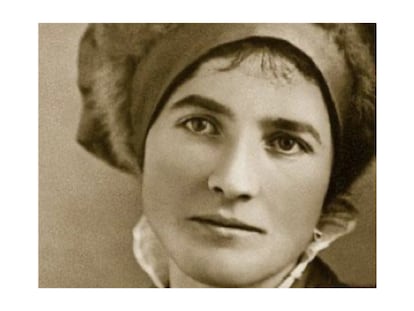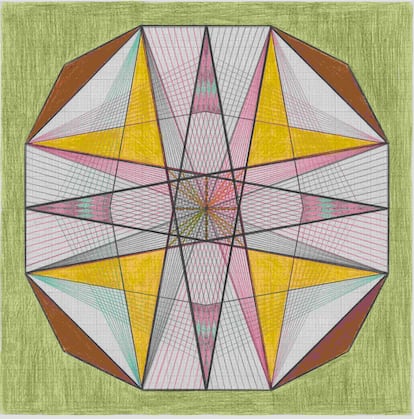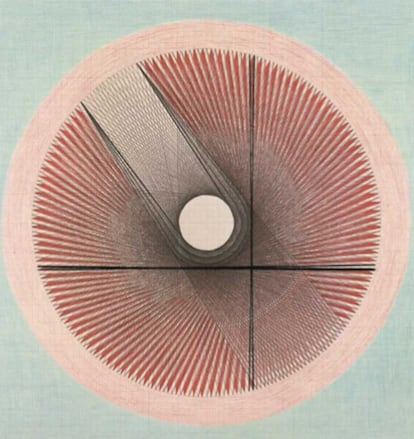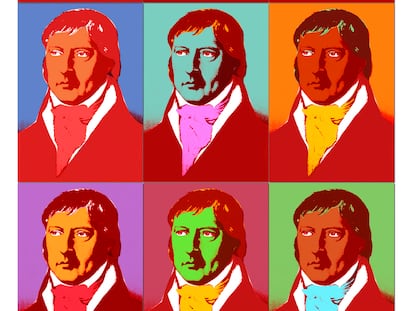Emma Kunz: The artist and healer who may have predicted the atomic bomb
The Swiss spiritualist created an extensive body of drawings in the mid-20th century with a visual richness ahead of her time. An exhibition at the Tabalakera exhibition center in Spain contextualizes her legacy

In 1941, the artist Emma Kunz (1892-1963) discovered a type of powder in the Roman mines of Würenlos, northwest of Zurich, which she named AION A. It turned out to be a remedy for inflammation, and the Swiss visionary used it to treat the quarry owner’s son for polio. “Würenlos is a powerful place in the middle of nature, it has a magical atmosphere and transmits a lot of energy. The first time I visited, I felt like electricity was running through the walls,” explained Yasmin Afschar, art historian and the curator of a new exhibition of Kunz’s work. Called Emma Kunz Cosmos: A visionary in dialogue with contemporary art, the show will be on display at the Tabakalera in the Spanish city of San Sebastián until June 19.
Afschar’s first contact with Kunz’s work was in these quarries, now known as the Emma Kunz Zentrum (Emma Kunz Center), before she became acquainted with her conceptual artworks. “Kunz always considered herself a scientist, and people came to her as a healer. She also possessed great knowledge about the medicinal use of plants, and she was a great naturopath. But there was also her artistic side,” reflected Afschar a few hours ahead of the exhibition opening.
Kunz created more than 500 works as tools to cure her patients, but none of them saw the light of day until 1973 – 10 years after her death – when they were exhibited for the first time at the Aargauer Kunsthaus art center in the Swiss town of Aarau. After being shown at the 2013 Venice Biennale and then at London’s Serpentine Gallery in 2019, interest in Kunz’s work has grown. “The figure of Emma Kunz, who never defined herself as an artist nor exhibited during her lifetime, allows us to inquire into the redefinition of what art is and who artists are,” explained Clara Montero, the Tabakalera’s cultural director.
A dialogue has been created between 40 of her drawings and the work of 18 international and local artists in the Tabakalera’s main hall, showing Kunz’s life and work against the backdrop of contemporary creatives. “The fascination for Emma Kunz is now greater than ever, and she could be considered an artist’s artist. In a contemporary space like the Tabakalera, it is unusual for us to dedicate an exhibition to a historical figure who died 60 years ago, but we think she deserves it. The exhibition not only delves into the figure of Emma Kunz, but also into the relevance of her ideas and approaches,” Clara Montero added. The group show, developed together with the Aargauer Kunsthaus museum, includes contemporary drawing (Diego Matxinbarrena), painting (Agnieszka Brzeżańska, Mathilde Rosier), photography (Joachim Koester), sculpture (Nora Aurrekoetxea, Goshka Macuga), neon installations (Mai-Thu Perret), video projections (Shana Moulton) and an interactive installation exploring childhood fears by Brazilian artist Rivane Neuenschwander.

Categorizing Kunz’s art is as complex as her multifaceted identity. Born in the Brittnau countryside, she was convinced that she possessed clairvoyant and telepathic powers from an early age, and wanted to use them to help others. Without any academic training but guided by a holistic awareness of her fellow human beings, she treated a large number of patients using herbal concoctions and the creation of drawings with strict geometric rules on a large scale. Kunz largely worked with a pendulum, compass and ruler, the pendulum consisting of a chain and two balls – one of silver and the other of jade – to pick up electrical stimuli. By swinging the pendulum, she marked the points and central lines of its trajectory, and then joined them with a pencil. On graph paper, Kunz assigned sections colors and shapes, which she then drew and filled in sessions lasting up to 48 hours without breaks.
The results were patterns that mutated into infinite, vibrant geometries. “Mathilde Rossier, one of the artists present at the show, saw a person stand for 10 minutes with her eyes closed in front of one of her works,” noted Yasmine Afschar. For Tabakalera’s cultural director, the way the human eye is drawn to her work has a double effect: “Her work has a quality that invites us to look at it in great detail and discover its meticulous creation. But we can also do so with a certain distance, to see if we are able to identify the patterns, and that order, rhythm and energy that Kunz was looking for.”

The absence of dates or titles on her work makes chronology difficult, although those close to her suggest that the first drawings date from 1938 and lasted until the end of her life. If we consider Wassily Kandinsky’s essay On the Spiritual in Art (1911) and the more prolific work of fellow artist Paul Klee, it would be logical to classify Kunz’s art as abstract, but the absence of any contact with the art scene in her lifetime forces us to discard this hypothesis. “Emma Kunz had a very traditional way of understanding art. The only artists she knew were Swiss landscape artists, with very classical notions of painting. Her drawings follow a pattern of abstraction and use the same geometric language but their intention is quite the opposite of that abstract, modernist idea of l’art pour l’art. Kunz pursued a purpose, an objective,” explained Afschar, namely to help heal her patients. Kunz never considered herself an artist as such, “basically because the conventional idea she had of art was not what she was doing,” the curator concluded.
With no real written documentation to back it up, the most widespread theory is that the cross structures in her drawings are linked to moral and religious categories; the eternal above, the earthly below, evil on the left and good on the right. “According to the testimony of some neighbors and friends, everything indicates that Kunz was fairly close to Christianity. This is seen in the repeated use of crosses symbolizing the division between good and evil. However, this also invites us to think about the relationship between man and woman, or that of life itself with the cosmos,” said Afschar.

The most controversial idea surrounding her work concerns work No. 20, which Kunz produced after the outbreak of World War II in 1939. A hundred or so red rays pass through two thick, black lines, and are said to be Kunz’s interpretation of the future of the war. Contemporaries venture it was her way of conceptualizing a weapon with the potential to destroy the world. “Yes, it is often thought to be related to the atomic bombs that detonated in Japan in 1945, but these are only hypotheses,” noted Afschar.
The metaphysical charge of her work, and a possible link to esotericism and pseudo-scientific methods that raged in the first half of the 20th century, have set Kunz’s work in the canon of other female figures who also acted as mediums through their art, such as Georgiana Houghton, Agnes Martin and Hilma af Klint. She has another parallel with the latter. Despite having academic training and cultivating abstraction before Kandinsky or Mondrian, Af Klint expressly wanted her work to be exhibited only after 20 years had passed since her death. Emma Kunz has joined that long list of female artists and pioneers who still do not have their merited place in the art books, but whose work is better known than ever.
Tu suscripción se está usando en otro dispositivo
¿Quieres añadir otro usuario a tu suscripción?
Si continúas leyendo en este dispositivo, no se podrá leer en el otro.
FlechaTu suscripción se está usando en otro dispositivo y solo puedes acceder a EL PAÍS desde un dispositivo a la vez.
Si quieres compartir tu cuenta, cambia tu suscripción a la modalidad Premium, así podrás añadir otro usuario. Cada uno accederá con su propia cuenta de email, lo que os permitirá personalizar vuestra experiencia en EL PAÍS.
¿Tienes una suscripción de empresa? Accede aquí para contratar más cuentas.
En el caso de no saber quién está usando tu cuenta, te recomendamos cambiar tu contraseña aquí.
Si decides continuar compartiendo tu cuenta, este mensaje se mostrará en tu dispositivo y en el de la otra persona que está usando tu cuenta de forma indefinida, afectando a tu experiencia de lectura. Puedes consultar aquí los términos y condiciones de la suscripción digital.
More information
Últimas noticias
Tiger Woods turns 50: Will he continue playing on the PGA Tour or take a back seat?
The surreal journey of James Nnaji, the Barcelona youth player selected in the NBA Draft who ended up in the NCAA
Trump claims peace in Ukraine is near, but Moscow suggests otherwise
A survivor’s account of the Interoceanic Train accident: ‘We were scared because of the speed on the curve’
Most viewed
- Oona Chaplin: ‘I told James Cameron that I was living in a treehouse and starting a permaculture project with a friend’
- Reinhard Genzel, Nobel laureate in physics: ‘One-minute videos will never give you the truth’
- Why the price of coffee has skyrocketed: from Brazilian plantations to specialty coffee houses
- Pablo Escobar’s hippos: A serious environmental problem, 40 years on
- Chevy Chase, the beloved comedian who was a monster off camera: ‘Not everyone hated him, just the people who’ve worked with him’











































